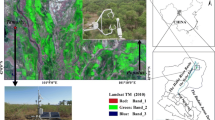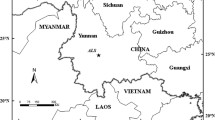Abstract
Among previous studies, there are large discrepancies in the difference between evapotranspiration from wetland vegetation and evaporation from open water. In this study, we investigate evapotranspiration differences between water and vegetation in a scenario that has otherwise not been extensively investigated: evapotranspiration from floodwaters in the sub-canopy environment. This study was conducted under a closed canopy baldcypress-ash-tupelo swamp forest in southeastern Louisiana. Water levels were measured in paired, partially-submerged evaporation pans, one with floating aquatic vegetation and the other without. Over the 5 month measurement period (June-November), average evapotranspiration rates from floating vegetation and open water were approximately 1.35 ± 0.10 and 1.36 ± 0.06 mm day−1, respectively. Open water evaporation was generally higher in summer, and evapotranspiration from the vegetated water surface was higher in fall, likely due to changes in the sub-canopy energy environment related to both regional climate and site canopy phenology.




Similar content being viewed by others
References
Abtew W (1996) Evapotranspiration measurements and modeling for three wetland systems in south Florida1. Journal of the American Water Resources Association 32:465–473. doi:10.1111/j.1752-1688.1996.tb04044.x
Abtew W (2005) Evapotranspiration in the everglades; comparison of Bowen ratio measurements and model estimations. American Society of Agricultural Engineers 2005 Annual Meeting. doi: 10.13031/2013.19812
Abtew DW, Melesse PDA (2013) Wetland evapotranspiration. Evaporation and evapotranspiration measurements and estimations. Springer, Netherlands, pp 93–108
Allen YC, Suir GM (2014) Using high-resolution, regional-scale data to characterize floating aquatic nuisance vegetation in coastal Louisiana navigation channels. Army Corps of Engineers Vicksburg, MS, No. ERDC/TN APCRP-EA-27
Allen LH Jr, Sinclair TR, Bennett JM (1997) Evapotranspiration of vegetation of Florida: perpetuated misconceptions versus mechanistic processes. Proceedings - Soil and Crop Science Society of Florida 56:1–10
Allen ST, Edwards BL, Keim RF, Reba ML (2014) Measurement of sub-canopy evaporation in a flooded forest. Evapotranspiration: Challenges in Measurement and Modeling from Leaf to the Landscape Scale and Beyond Conference Proceedings of the American Society of Agricultural Engineers. doi: 10.13031/et.1815545
Allen ST, Whitsell ML, Keim RF (2015) Leaf area allometrics and morphometrics in baldcypress. Canadian Journal of Forest Research 45:963–969. doi:10.1139/cjfr-2015-0039
Andersen IH, Dons C, Nilsen S, Haugstad MK (1985) Growth, photosynthesis and photorespiration of Lemna gibba: response to variations in CO2 and O2 concentrations and photon flux density. Photosynthesis Research 6:87–96. doi:10.1007/BF00029048
Anderson MG, Idso SB (1987) Surface geometry and stomatal conductance effects on evaporation from aquatic macrophytes. Water Resources Research 23:1037–1042. doi:10.1029/WR023i006p01037
Blanken PD (1998) Turbulent flux measurements above and below the overstory of a boreal aspen forest. Boundary-Layer Meteorology 89:109–140. doi:10.1023/A:1001557022310
Brown S (1981) A comparison of the structure, primary productivity, and transpiration of cypress ecosystems in Florida. Ecological Monographs 51:403–427. doi:10.2307/2937322
Burba GG, Verma SB, Kim J (1999) A comparative study of surface energy fluxes of three communities (Phragmites australis, Scirpus acutus, and open water) in a prairie wetland ecosystem. Wetlands 19:451–457. doi:10.1007/BF03161776
Couvillion BR, Barras JA (2006) Late 20th century land use / land cover changes in the northern Gulf Coast. http://ngom.usgs.gov/task3_3/
Crundwell ME (1986) A review of hydrophyte evapotranspiration. Revue d’Hydrobiologie Tropicale 19:215–232
de la Sota ER, de Pazos LAC (1990) On the stomata of Salvinia herzogii (Salviniaceae, Pteridophyta). Plant Systematics and Evolution 172:119–125. doi:10.1007/BF00937802
Dingman SL (2002) Physical hydrology. Waveland Press, Inc., Long Grove
Drexler JZ, Snyder RL, Spano D, Paw UKT (2004) A review of models and micrometeorological methods used to estimate wetland evapotranspiration. Hydrological Processes 18:2071–2101. doi:10.1002/hyp.1462
Egertson CJ, Kopaska JA, Downing JA (2004) A century of change in macrophyte abundance and composition in response to agricultural eutrophication. Hydrobiologia 524:145–156. doi:10.1023/B:HYDR.0000036129.40386.ce
Eisenlohr WS (1966) Water loss from a natural pond through transpiration by hydrophytes. Water Resources Research 2:443–453. doi:10.1029/WR002i003p00443
Ewel KC, Smith JE (1992) Evapotranspiration from Florida pondcypress swamps. Journal of the American Water Resources Association 28:299–304. doi:10.1111/j.1752-1688.1992.tb03995.x
Guenther SM, Moore RD, Gomi T (2012) Riparian microclimate and evaporation from a coastal headwater stream, and their response to partial-retention forest harvesting. Agricultural and Forest Meteorology 164:1–9. doi:10.1016/j.agrformet.2012.05.003
Hough RA, Fornwall MD, Negele BJ et al (1989) Plant community dynamics in a chain of lakes: principal factors in the decline of rooted macrophytes with eutrophication. Hydrobiologia 173:199–217. doi:10.1007/BF00008968
Jarvis PG, McNaughton KG (1986) Stomatal control of transpiration: scaling up from leaf to region. In: Ford AM (ed) Advances in ecological research. Academic, pp 1–49
Kettridge N, Thompson DK, Bombonato L et al (2013) The ecohydrology of forested peatlands: simulating the effects of tree shading on moss evaporation and species composition. Journal of Geophysical Research, Biogeosciences 118:422–435. doi:10.1002/jgrg.20043
Krauss KW, Duberstein JA, Conner WH (2014) Assessing stand water use in four coastal wetland forests using sapflow techniques: annual estimates, errors and associated uncertainties. Hydrological Processes. doi:10.1002/hyp.10130
Liu S (1996) Evapotranspiration from cypress (Taxodium ascendens) wetlands and slash pine (Pinus elliottii) uplands in north-central Florida. Dissertation, University of Florida
Liu S, Riekerk H, Gholz HL (1998) Simulation of evapotranspiration from Florida pine flatwoods. Ecological Modelling 114:19–34. doi:10.1016/S0304-3800(98)00103-3
Luque GM, Bellard C, Bertelsmeier C et al (2013) The 100th of the world’s worst invasive alien species. Biological Invasions 16:981–985. doi:10.1007/s10530-013-0561-5
Mao LM, Bergman MJ, Tai CC (2002) Evapotranspiration measurement and estimation of three wetland environments in the Upper St. Johns River Basin, Florida. Journal of the American Water Resources Association 38:1271–1285. doi:10.1111/j.1752-1688.2002.tb04347.x
Masoner JR, Stannard DI, Christenson SC (2008) Differences in evaporation between a floating pan and Class A Pan on land. Journal of the American Water Resources Association 44:552–561. doi:10.1111/j.1752-1688.2008.00181.x
Mitsch WJ, Gosselink JG (2007) Wetlands, 4th edn. Wiley, New York
Monteith J, Unsworth M (2008) Principles of environmental physics, 3rd edn. Academic, Burlington
Parkhurst RS, Winter TC, Rosenberry DO, Sturrock AM (1998) Evaporation from a small prairie wetland in the Cottonwood Lake area, North Dakota—an energy-budget study. Wetlands 18:272–287. doi:10.1007/BF03161663
Rao AS (1988) Evapotranspiration rates of Eichhornia crassipes (Mart.) Solms, Salvinia molesta d.s. Mitchell and Nymphaea lotus (L.) Willd. Linn. in a humid tropical climate. Aquatic Botany 30:215–222. doi:10.1016/0304-3770(88)90052-6
Raz-Yaseef N, Rotenberg E, Yakir D (2010) Effects of spatial variations in soil evaporation caused by tree shading on water flux partitioning in a semi-arid pine forest. Agricultural and Forest Meteorology 150:454–462. doi:10.1016/j.agrformet.2010.01.010
Reba ML, Pomeroy J, Marks D, Link TE (2012) Estimating surface sublimation losses from snowpacks in a mountain catchment using eddy covariance and turbulent transfer calculations. Hydrological Processes 26:3699–3711. doi:10.1002/hyp.8372
Reifsnyder WE, Lull HW (1965) Radiant energy in relation to forests. U.S. Department of Agriculture, Forest Service Technical Bulletin No. 1344, Washington, DC, USA
Rogers HH, Davis DE (1972) Nutrient removal by waterhyacinth. Weed Science 20:423–428. doi:10.2307/4042146
Shoemaker WB, Sumner DM, Castillo A (2005) Estimating changes in heat energy stored within a column of wetland surface water and factors controlling their importance in the surface energy budget. Water Resources Research 41. doi: 10.1029/2005WR004037
Snyder RL, Boyd CE (1987) Evapotranspiration by Eichhornia crassipes (Mart.) Solms and Typha latifolia L. Aquatic Botany 27:217–227
Sun G, Riekerk H, Comerford NB (1998) Modeling the forest hydrology of wetland-upland ecosystems in Florida. Journal of the American Water Resources Association 34:827–841. doi:10.1111/j.1752-1688.1998.tb01519.x
Tillberg E, Dons C, Haugstad M, Nilsen S (1981) Effect of abscisic acid on CO2 exchange in Lemna gibba. Physiologia Plantarum 52:401–406. doi:10.1111/j.1399-3054.1981.tb02707.x
Wilson KB, Hanson PJ, Baldocchi DB (2000) Factors controlling evaporation and energy partitioning beneath a deciduous forest over an annual cycle. Agricultural and Forest Meteorology 102:83–103
Acknowledgments
Project funding was provided by the Lucius W. Gilbert Foundation, a Grant-In-Aid of Research from Sigma Xi, The Scientific Research Society, and the National Institute of Food and Agriculture, U.S. Department of Agriculture, under award LAB94181. We thank the anonymous reviewers for their useful comments. Any opinions, findings, conclusions, or recommendations expressed in this publication are those of the author and do not necessarily reflect the view of the U.S. Department of Agriculture.
Author information
Authors and Affiliations
Corresponding author
Rights and permissions
About this article
Cite this article
Allen, S.T., Edwards, B.L., Reba, M.L. et al. Sub-canopy Evapotranspiration from Floating Vegetation and Open Water in a Swamp Forest. Wetlands 36, 681–688 (2016). https://doi.org/10.1007/s13157-016-0778-z
Received:
Accepted:
Published:
Issue Date:
DOI: https://doi.org/10.1007/s13157-016-0778-z




